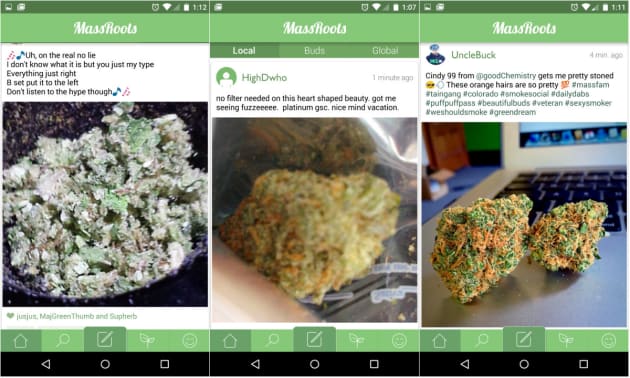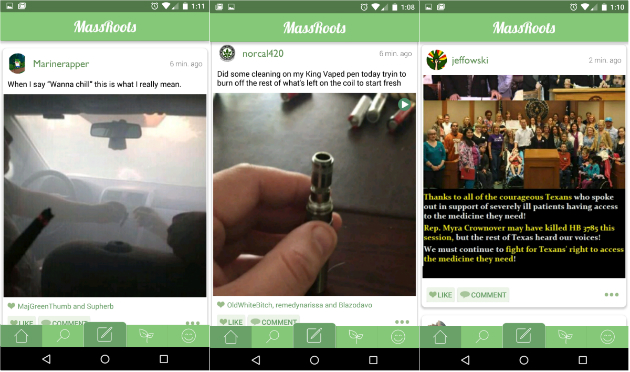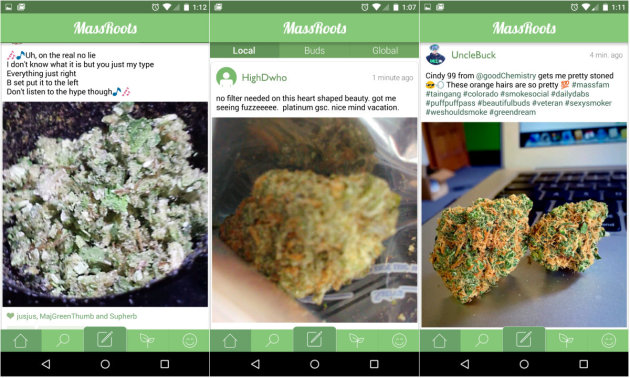5 ways the new connected agriculture world changed in 2016
Cannabis or “weed” is, in practical terms, going mainstream. It’s no longer exclusively sold from basements and back alleys; in 23 states and Washington D.C., it’s sold from licensed and bonded shops. The cannabis movement has done a lot of growing up over the past couple of years as its public acceptance has skyrocketed across the US. Cannabis itself has gone from a black market “gateway” drug that funded the atrocities of Mexican cartels to a potential super-medicine drawing the attention of Wall Street’s most powerful investors and all seemingly overnight.
But is cannabis culture really ready for this sea change of support? Can users get over their self-perpetuating stereotypes and celebrate this pastime as coffee and cocktail enthusiasts do — by spamming their Instagram followers with inane pictures of what they’re about to consume? If the MassRoots photo-sharing app, billed as the “Instagram for weed,” is any indication, probably not.
I should first point out that I grew up in San Francisco. I smoked cannabis regularly for years before taking a drag of my first cigarette or even a sip of beer. Cannabis use wasn’t just normalized when I was a teenager; it was blasé. Everybody from my bus drivers to my public school teachers — heck, even my old scoutmaster — got lit on the regular and with surprisingly little pomp or circumstance. As such, much of the “cannabis pop culture” that many people relish has always come across as comical and amateurish to me. I mean, who actually wants to be that stereotypical, “Whoa look at my hands, THEY’RE HUGE!” kind of stoner? Who wants to be that one asshole who reeks of patchouli oil and can’t stop talking about how hash rips cured his gout?

As cannabis transitions from the counterculture to the mainstream, people are beginning to treat it like our other two favorite low-level intoxicants: coffee and beer. This includes not only obsessing over the origins, production methods, flavor and preparation of the product itself, but also over the ever-more intricate apparatus needed to consume them. Just as freeze-dried Folgers in a percolator coffee maker has been supplanted by Keurig K-cups, apples and proto-pipes have been replaced by dab sticks and vapor pens. And just as craft beer makers obsess over the quality over every hop, so too do stoners over the appearance and potency of their favorite strains.
As cannabis transitions from the counterculture to the mainstream, people are beginning to treat it like coffee and beer.
And just as people obsessively snap pictures of what they’re eating and drinking to post to Instagram, so too do many stoners with what they’re smoking. But that’s where the trouble starts. While getting shitfaced at 10 AM on a Sunday (aka “brunch”) is a perfectly acceptable use of Instagram, the site’s Community Guidelines specifically prohibit users from posting pictures of cannabis and other intoxicants. It specifically states, “Promoting recreational drug use is also not allowed.” There’s also the issue of police trawling through the app looking for people to arrest and the fact that cannabis is (for the time being) still a federally prohibited Schedule I drug.
And that’s where the MassRoots app comes in. The so-called Instagram of weed reportedly offers its users the ability to share their cannabis-related photos freely, safely and without any fear of violating their terms of service or running afoul of state medical marijuana laws. This is supposedly because the app is only made available to users in states that allow medical marijuana. During the initial setup, however, the only “verification” the iOS and Android app performed was to have me pick a state out of a list of 23 where medical cannabis is legal. I wasn’t required to disclose my patient ID number nor upload a scan of my doctor’s recommendation — nothing. It’d be no harder for a person from a non-MMJ state to game the app’s security than it would be for a 12-year-old to figure out how to subtract 18 from the current calendar year to get into a porn site. What’s more, even picking an MMJ state from this app’s list still isn’t going to protect you from either the DEA or overzealous local law enforcement.

Security concerns aside, the app itself functions uncannily like Instagram. Users can upload and share photos, like and comment on the pictures of others and follow other users’ streams. It’s really just like Instagram except the pictures are of glassware (e.g., hash pipes and bongs), nuggets of cannabis and flowering grow houses instead of fancy cocktails, tapas and your cat. Rap group Cypress Hill’s B Real is a member of the site and users like Valleyrec420, NativeRoots and MassGlass all offer professional-looking photo streams as well. Surprisingly, marquee cannabis groups like Stoned Society, High Times and NORML were nowhere to be found.
It’s just like Instagram except the pictures are of glassware, nuggets of cannabis and flowering grow houses instead of fancy cocktails, tapas and your cat.
I was also amazed by the lack of dispensaries using the app. It seems the perfect platform to connect with potential customers and yet I couldn’t find a single shop in San Francisco that used MassRoots. There are also no fewer than 48 people impersonating Snoop Dogg on the site so good luck trying to follow him. In short, with a significant portion of the content on this app being recycled from other sources — be it Tumblr or Reddit’s r/trees — it’s really difficult to know who’s worth following.
Unfortunately, the majority of MassRoots’ users are not gifted photographers (being stoned clearly doesn’t help matters either) so images are not typically of the best quality… or even in focus all that often. That’s not to say you can’t find great accounts; you’re just going to need to wade through a significant number of people snapping overexposed shots of pipes, Bic lighters and their hazy college dorm rooms to find the good stuff.

MassRoots, despite clearly being modeled after Instagram, does lack some of the more popular apps functionality. Direct messages, for example, are nonexistent. But for what MassRoots lacks in a large user base, it makes up for in user interaction. I posted a single picture to MassRoots and have already garnered more followers than I have on Instagram. Plus, looking through the feeds you see that virtually every single comment on posts is positive and supportive.
Overall, trawling through MassRoots is a lot like walking through a Cannabis Cup: equal parts enthusiasm and self-parody. It’s great to see people publicly embracing an American pastime that, 20 years ago, would have landed you in federal prison. But, seriously, how many goddamn times do I need to read the phrase, “Looooool I’m high AF” in a three-minute period? How many macro shots of generic nugs and sheets of wax do I have to see before they all blend into an eye-glazing morass? Turns out, about 45 of them.
Maybe my disappointment with MassRoots isn’t with the site itself or its largely millennial user base. Maybe the problem is me. It might be because I’ve been so inundated with the idea that cannabis is equivalent to alcohol that photos of people wearing hemp cowboy hats and fan-leaf leis makes me cringe. Or maybe it’s just as Lethal Weapon’s Roger Murtaugh once said: “I’m getting too old for this shit.”
[Image credits: Blaine Harrington III / Alamy (top image); MassRoots (screenshots)]
5 ways the new connected agriculture world changed in 2016

The world of agriculture technology, or agtech, is rapidly evolving from an industry entrenched in tradition to one that is fast embracing change. It’s automating laborious tasks and providing farmers and growers with greater knowledge and insight into their crops than ever before. As technology evolves so does the needs of the farmer and the growing environment. Here are some of the biggest trends of 2016:
1. Sensor tech in the field and on the farm

Today’s farmer is as likely to have an iPhone and iPad as a pitchfork in hand as they utilize IoT technology to get the most accurate information about the weather and growing conditions, soil quality and moisture and other information that previously was unavailable or difficult to attain in real time.
Even traditional companies like John Deere have created connected platforms and vehicles along with a suite of start-ups intent on modernizing farming through increased technological insight. One such company providing solutions is Arable, an agtech start-up who have created the PulsePod, a six-band spectrometer, four-way net radiometer, and acoustic rain gauge that measures more than 40 observation streams including rain, hail, canopy leaf area, crop water demand, environmental stresses, microclimate, and even air pollution. It’s always on and always connected (built-in Bluetooth, wifi, and cellular).
It’s built for security (military grade encryption), flexibility (an API to plug the data into existing platforms), and control (customers choose how/when/what data to share) and enables unprecedented visibility for what’s happening in the field. As founder, Adam Wolf explained:
“for the first time we see farmers able to manage the response of crops to the weather, processors can predict future yield so they can make marketing decisions, we start to see insurance stepping in to cover risk for small holder agriculture, we really see opening up for these parts of the market that are previously inaccessible in terms of risk. This includes drought forecasting and food security; forest and crop responses to weather and climate change; and rural water usage.”
2. Indoor and urban farming

Currently around 20% of the world’s food production is grown within cities rather rural areas and inherent in this is the multi-billion dollar industry of indoor growing and hydroponics. The industry includes $ 5 billion in urban farming in the US and $ 5.7 billion for legal cannabis production. The latter is significant as figures are set to rise with the increased legalization of marijuana as the US.

One company creating solutions for the home grower is Leaf who have developed a self-contained plug and plant system that automatically grows ‘medicinal’ plants and vegetables that are controlled via smartphone technology. The system provides all the pumps, lights, carbon filter fans (to avoid your home smelling like a marijuana plantation) and nutrients needed to raise a pair of cannabis plants and yield 4 to 5 ounces of marijuana.
It also includes a host of environmental sensors and an HD camera that push data (and a time-lapse view of your plants) to your smartphone for continuous tracking. However, it’s not exactly cheap to run with electricity costs alone estimated a between $ 15-$ 50 per month so it would be interesting to see future solar applications.
Another approach to urban farming is Freight Farms who take an innovative approach to farming, growing crops inside repurposed shipping containers, called Leafy Green Machines- literally a freight-truck-sized farm-in-a-box, with all the necessary equipment and storage required to grow produce.

It is hoped that the use of an IoT platform will allow for more detailed monitoring of growing conditions in real-time. By using LogMeIn’s IoT platform Xively, it enables farmers to assess their crops remotely, tracking features such as temperature, humidity, CO2 levels and plant growth.
Alerts are delivered whenever any of these metrics fall out of the ideal growing range. The data collected from users also enables Freight Farms to improve their services, giving them greater insight into how customers are utilizing their products. Container gardening is nothing new in urban areas, but it’s foreseeable that the water-efficient containers could be of benefit to regions where drought causes a barrier to farming.
3. Edible insects and plant-based nutrients

Insect protein is poised to become a big part of the global food supply. Commonly enjoyed in many non-Western countries they are easy to breed, with a low-carbon input. One US-based company, Tiny Farms which relies on IoT and automation to build smart, easily scalable farming systems for insect growth. These include complete sensor integration and a data capture platform for monitoring, analysis, and optimization. A corresponding app provides appropriate tracking to ensure your herd is healthy.
Farming also meets food tech as a proliferation of start-ups have emerged over the last year to rival Soylent in the powdered food supplement/substitute market. Almost every start-up conference I have attended in 2016 has included at least three different vendors. Whether it can be considered farming (or manufacturing) is up for debate, but there’s certainly technology in the process.
4. What about the robots?

A 2012 Agriculture Census revealed that during the past 30 years the average age of U.S. farmers has grown by nearly eight years, from 50.5 years to 58.3 years. This is a concern for the future of farming since there are fewer individuals choosing to farm than before. Thus, it’s entirely possible that robots could meet the employee demand agriculture over the next two decades, especially since they become smarter and cheaper.
5. Cost remains a barrier
While the IoT has a strong presence in farming, it’s not without its’ critics with a report by Lux Research in June suggesting that service costs and niche products are slowing down the adoption of new technologies. Traditionally an industry subsidized in many parts of the world, farming relies on profits through an increased yield and cost savings of water and fertilizer to ensure that technological innovations can be truly effective and provide solutions to the challenges of modern farming.
What’s also needed is appropriate mobile coverage across the many acres of farming land, often so extensive it requires visitation by helicopter. Narrow-Band IoT (NB-IoT) standards will help ensure the breadth of coverage of mobile networks across the fields as well as devices where batteries may not need to be replaced for some years. It will also help extend coverage into cellars, barns, and silos inaccessible via cell signals, actually connecting alarms, sensors, meters, and many more IoT devices
The post 5 ways the new connected agriculture world changed in 2016 appeared first on ReadWrite.
(72)





